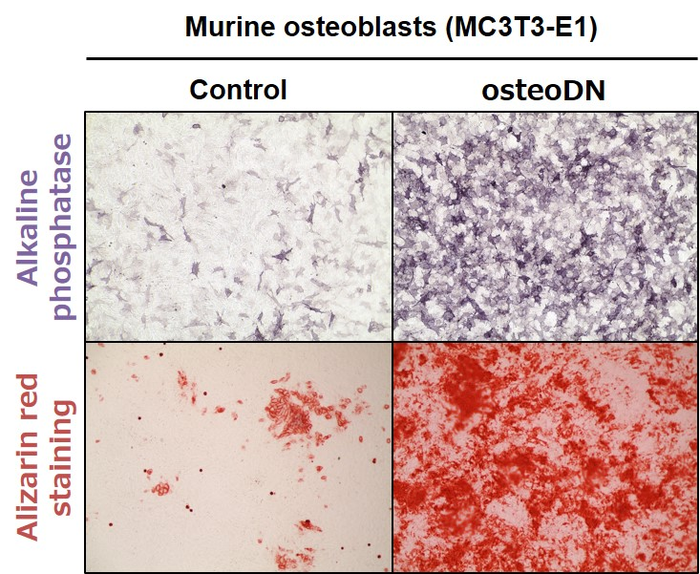Bone tissue homeostasis is maintained by a balance between bone formation by osteoblasts and bone resorption by osteoclasts. However, when osteoblast function declines with age, bone remodeling becomes out of balance, bone mass and density decrease, and osteoporosis occurs, effecting 200 million people around the world. Molecules that activate osteoblasts and promote bone differentiation are thought to be drug discovery seeds for osteoporosis.

Credit: Modified from Nihashi et al., Nanomaterials (2022) 12: 1680.
Bone tissue homeostasis is maintained by a balance between bone formation by osteoblasts and bone resorption by osteoclasts. However, when osteoblast function declines with age, bone remodeling becomes out of balance, bone mass and density decrease, and osteoporosis occurs, effecting 200 million people around the world. Molecules that activate osteoblasts and promote bone differentiation are thought to be drug discovery seeds for osteoporosis.
The research group lead by Assistant Professor Tomohide Takaya previously discovered an oligodeoxynucleotide (ODN) that induces muscle differentiation. The research group thought that there might be an ODN that promotes bone differentiation and conducted this study. As a result, the group succeeded in identifying an 18-base osteogenetic ODN (osteoDN), iSN40, that promotes the differentiation of mouse osteoblasts from 44 types of ODN derived from the genomic sequence of lactic acid bacteria. The study confirmed that iSN40 has the effect of inducing the expression of genes required for bone differentiation and maturing calcium-deposited bone cells. iSN40 is expected to be applied as a nucleic acid drug useful for the treatment of osteoporosis as an ODN that activates osteoblasts.
The intent of this study was to act directly on the osteoblasts and promote bone differentiation, and to discover nucleic acid drug seeds that are useful for the treatment of osteoporosis. Although many people are at risk of bone fracture due to osteoporosis, the therapeutic agents currently in use are protein / peptide preparations such as antibodies and hormones (denosumab, romosozumab, etc) which are hard to produce in mass and remain expensive. On the other hand, nucleic acids can be synthesized inexpensively. Therefore, Assistant Professor Takaya hoped to propose the possibility of nucleic acid drugs for osteoporosis, because nucleic acids are easy to manufacture and store, and offer potential nanomolecules for next-generation drugs.
The research group was prepared to examine numerous DNA sequences and conduct lengthy experiments in their search for osteoDNs, which at the time was unknown if they may or may not exist. They were prepared for a long experimental period examining many DNA sequences but were pleasantly surprised by how easy it was to find the ODN as seen in Figure 1 in the article. One might think that it was perhaps simply luck, or rather, Assistant Professor Takaya believes, it is the fact that we have not yet discovered osteoDNs. There may be far more ODN sequences, such as osteoDN, that affect the fate of cells than we had previously thought.
OsteoDNs which are short single-stranded DNA can promote the formation of bone cells. This bone-forming osteoDN is expected as a therapeutic drug for osteoporosis. The next step is to demonstrate the effect of bone-forming osteoDNs in animal models. Ultimately, the goal is to apply it in clinical setting as medicine for osteoporosis.
###
For more information please read: https://doi.org/10.3390/nano12101680
Funding: This research was funded by The Japan Society for the Promotion of Science, grant numbers
19K05948 and 22K05554.
Shinshu University has been assigned the invention of osteoDN by T.T., Y.N., K.U., and T.S., and Japan Patent Application 2021-122713 has been filed on 27 July 2021.
Journal
Nanomaterials
DOI
10.3390/nano12101680
Method of Research
Experimental study
Subject of Research
Cells
Article Title
Identification of a Novel Osteogenetic Oligodeoxynucleotide (osteoDN) That Promotes Osteoblast Differentiation in a TLR9-Independent Manner
Article Publication Date
14-May-2022




